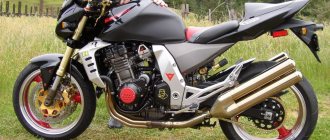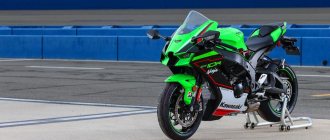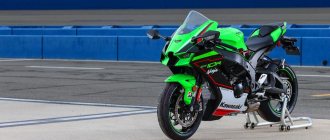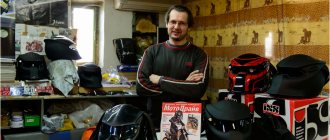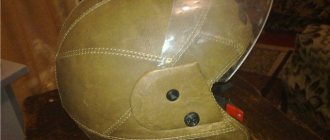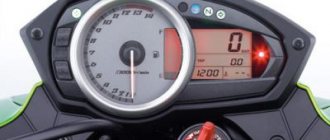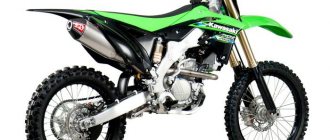Style, dynamics, power... That's what can be said about the new model from the Z1000 R Edition 2021. When you see this motorcycle, you understand that it can inspire not only a connoisseur, but also a person completely far from the topic. The design of this beast itself is so aggressively elegant that associations with high speed and power immediately arise.
Like other representatives of the legendary Kawasaki z1000 series, the R edition is distinguished by its balance and a high degree of thoughtfulness. The convenience of the motorcycle is beyond praise! According to reviews from drivers, it sometimes seems that you and the motorcycle are one whole.
Specifications
The excellent design is not inferior to the filling: only the best components for fast and safe driving are perfectly combined in a reliable body. This is a fine example of the Kawasaki z1000, the technical details of which are reviewed below.
Engine
It cannot be said that the engine is the most important thing in a motorcycle, but still... The solution chosen for the R edition is a very powerful engine that is suitable for different road conditions. In addition to its unconditional power, it will give you good control over the “steel mustang”.
The engine capacity is 1043 cm3, which is enough for most lovers of urban aggressive bikes. Fuel will be consumed approximately 5-6 liters for every 100 kilometers. This in-line device has four strokes. It would hardly be possible to pick something better. Even the appearance of the engine impresses with its aesthetics and minimalism! Speed and flexibility are what this motor delivers.
The vibrations that occur in the bike will be damped by the damper. In this regard, the Kawasaki z1000 is an excellent example of both a powerful and “calm” machine. The muffler ensures that the driver practically does not feel the full power of this beast. By the way, this circumstance, as well as the instant acceleration, makes the motorcycle suitable only for experienced users. But this is by no means a minus of the model, but only a natural consequence of its colossal capabilities.
Street Predator KAWASAKI Z1000 R
Bold and aggressive lines, a swift and at the same time smooth silhouette of the new Z1000 R took the bike to a new stage in the evolution of KAWASAKI. The motorcycle's extensive functionality is successfully combined with a sleek appearance, and the new engine and chassis settings provide unrivaled rider compliance.
The Japanese word "sugomi" means a bright aura or energy emitted by a person or other object and felt by others. Someone or something with "sugomi" inspires awe, leaves a lasting impression, amazes in size or capability, and commands respect. The new KAWASAKI Z1000 R takes full advantage of this in its fierce, aggressive design and ready-to-go nature. Proper dimensions (slightly lowered front part and raised tail), a body kit that tightly fits the powerful frame - the bike resembles a predator, ready to pounce at any second. The brutal supernaked style hints at the motorcycle's suitability for sharp, breathtaking street riding.
A new powertrain, improved suspension and updated frame geometry make the predatory street bike even more aggressive. Characteristic graphics bring the motorcycle closer to racing prototypes in spirit, and new optics add convenience on unlit sections of the road. The motorcycle received 1.5 kg lighter alloy wheels, a fully electronic instrument panel and a comfortable steering wheel with a larger cross-section. The model is also equipped with reliable Brembo brake components, a 1,043 cc engine. cm, a reinforced frame and a modified intake system, thanks to which the acceleration of the bike can not only be felt, but also heard. The split-action front fork and the new Öhlins S46DR1S rear shock absorber have a positive effect on ride comfort.
An exhaust system with volumetric storage chambers and small mufflers, a horizontal rear swingarm arm serve to properly distribute the weight of the motorcycle. The horizontal rear swingarm frees up space to connect to the lower suspension arm, allowing for a larger exhaust pre-chamber, which in turn allows for shorter mufflers and promotes mass centralization. The lightweight aluminum rear subframe also has a positive effect on weight characteristics. The result of the efforts of the development engineers was the light, razor-sharp steering of the motorcycle. And the new muffler tips give a more modern and striking appearance to the overall image of the bike.
Pictured: KAWASAKI Z1000 R
In addition to improving performance, low-pressure throttle valves contribute to overall mass centralization by working in conjunction with larger exhaust plenums. The revised length of the intake funnel provides more powerful engine output at mid-range speeds.
The thick, wide steering wheel installed on the new model is ideal for the supernaked style and makes it easier to control. The wide aluminum handlebar tube is lightweight, has a matte finish and a black alumite finish.
The Z1000 R's instrument cluster, the result of a design flight of thought, is mounted directly on the handlebars and is compactly located behind the small head fairing. The low position of the windshield and its small size contribute to an unobstructed view of the road. The futuristic design of the LED tachometer and the LCD screen of the instrument panel are the implementation of modern technical solutions to unlock the sporting potential of the new KAWASAKI.
The new Z1000 R's more enjoyable and responsive handling can largely be attributed to its improved suspension. The modern Showa SFF-BP front fork provides both comfort and sporting potential, while being ideal for street riding. Combining SFF (Split Functional Fork) and BPF (Big Piston Fork) technologies, the new fork features preload springs on both sides in the left tube and a damper on the right side.
The lightweight tubular frame is constructed from 5 cast aluminum parts. The frame consists of a steering column, left and right main parts and two cross members. The two main elements have an open C-section and are molded in a special way to maintain a smooth and even surface. The very rigid frame made of light alloy uses the engine as a load-bearing element of the power structure. This solution contributes to easy handling and maintains excellent maneuverability and stability of the motorcycle.
The fuel tank volume of 17 liters will allow the owner to think less often about the need to visit a gas station, increasing autonomy of movement. And the exciting sound of the bike’s intake manifold is so calibrated by the manufacturer and pleasing to the ear of a city racer that you simply won’t want to stop moving.
Pictured: Z1000 R side view
The rear shock absorber, manufactured by the famous Öhlins brand, has pre-compression and rebound settings, adding convenience to the motorcycle in single mode and when riding with a passenger.
The motorcycle's 1,043 cc inline four-cylinder and four-stroke power unit. cm with a piston diameter and stroke of 77.0 x 56.0 mm, it has a liquid cooling system and a DOHC gas distribution system with 16 valves (4 valves per cylinder). The engine power supply system is implemented by digital fuel injection with four 38 mm oval sub-throttles manufactured by Keihin. The ignition is also controlled by an electronic unit. The engine lubrication system is implemented using a forced sump method (wet sump).
Maximum engine output is 143 hp. is achieved at 10,000 rpm, and the highest torque of 111 Nm is already at 7,300 rpm.
The bike is equipped with a six-speed gearbox and a multi-plate slipper clutch in an oil bath. The transmission of engine traction to the rear wheel is carried out via a chain drive.
The front suspension is a 41mm inverted fork with continuously adjustable compression and rebound damping, as well as spring preload. The rear suspension of the motorcycle is a gas-charged monoshock with continuously variable rebound and spring preload adjustment.
To bring the already excellent braking performance of the Z1000 R to an ideal level, the finest braking components, like those found on the Ninja H2R, were used. Brembo components are deservedly considered the best available for mass production models. High-precision mechanisms provide linear braking force, and the ABS system contributes to excellent handling. The front brakes consist of two Brembo semi-floating 310mm discs and M50 radial-mount dual monoblock four-piston front calipers, also from Brembo. At the rear there is a single 250mm petal disc with a single-piston caliper.
Pictured: another angle of the Z1000 R
Custom fuel tank graphics include a vibrant yellow and green accent that contrasts with the bike's dark paint job. The addition of R graphics to the color scheme as standard adds a pop of color to the bike and complements the overall design.
The Z1000 R's rims are approximately one and a half kilograms lighter than those of other models, which reduces the unsprung weight of the motorcycle and also improves steering qualities.
The bike's sleek and compact head fairing now sits even lower, visually continuing the line that begins at the top of the tank. For the first time, KAWASAKI uses a reflectorless LED headlight system. The use of LED lamps saves space, and the reflectorless lighting system gives the bike an even more predatory and purposeful look. Economical LED lamps operate on low (in the center) and high (outside) lighting. All four lamps light up when the high beams are on. There is a separate LED backlight on the odometer cover. The tail section of the motorcycle is equipped with an LED brake light, complementing the truly futuristic look of the bike.
The careful work of the manufacturer's engineers and designers is visible in every detail of the new KAWASAKI Z1000 R. The bike turned out to be muscular, tightly built, with a very aggressive and attractive appearance, and its technical equipment, as always, is at its best. You can view more detailed technical specifications and place an order on the MOTORRIKA website.
Dimensions and weight
The motorcycle has respectable dimensions, of course, within the framework of sports motorcycles of this class. The length of the bike is 2045 millimeters, its height is 1085, and its width is 790 millimeters. The seat height of the motorcycle is 815, the ground clearance is 140, and the wheelbase is 1440 millimeters. In terms of its curb weight, the “iron horse” gains 221 kilograms of dry weight, which is absolutely normal for bikes of this class.
When choosing a Kawasaki z1000, you need to pay special attention to the dimensions: the motorcycle is designed for more or less tall people, at least when it comes to a passenger. If you plan to ride alone, this bike is quite suitable for you, even if you are relatively short.
Chassis and brakes
The bike frame is aluminum. It is cast and double. Some people associate aluminum with something fragile, but here it is a serious frame that has enough rigidity to satisfy the technical potential of the Kawasaki z1000 motorcycle.
The rear suspension helps create comfort, because it is pendulum-type and equipped with a monoshock absorber, its travel is 122 millimeters. The front fork provides excellent handling of the new model; rebound and preload can be adjusted.
The steering wheel is made of aluminum with a larger cross-section, which is definitely a plus. It is coated with Alumite 1. Good control is achieved due to the large width of the pipe. If you want to see how easy the new Kawasaki z1000 is to ride, look no further than the rave reviews. Speaking of the control system, one cannot fail to note the excellent weight distribution. Both the throttle bodies and the rear horizontal shock absorber are top notch and, along with the sophisticated exhaust system, distribute the weight properly.
The lightweight rims of the motorcycle wheels are significantly lighter than those of the previous model (by 1.5 kg). This makes it easier to control and reduces the number of sprung masses. And how stylish these Kawasaki z1000 wheels look! Just look at the numerous photos!
It's time to pay attention to the brakes. Brembo - the braking components that are so necessary in this high-speed furious model! These brakes have an excellent reputation: not only production bike models have demonstrated excellent results with them, but also super-fast monsters! Controllability and smoothness are some of the operating principles of the local braking system, so the safety of the motorcycle is at the proper level. There is also an abs system.
KAWASAKI Z1000 R Edition 2021
Official Kawasaki warranty 2 years unlimited mileage.
Heir to the incredible Sugomi, the new Kawasaki Z1000 R Edition has a striking design, Brembo M50 brakes, Ohlins rear shock absorber and is fully Euro4 compliant. Having won hearts even before its premiere, the Kawasaki Z1000 R Edition will appeal to fans of the SuperNaked class and fans of aggressive riding.
Engine
Engine type Liquid cooled, 4-stroke in-line, four cylinders Displacement 1043 cm³ Bore and stroke 77 x 56 mm Compression ratio 11.8:1 Timing system DOHC, 16 valves Fuel system Fuel injection: Ø 38 mm x 4 (Keihin) with oval secondary throttle valves Ignition Electronic Starting system Electric Lubrication system Forced lubrication, wet sump
Features & Transmission
Maximum power 104.5 kW {142 hp} / 10,000 rpm Maximum torque 111 Nm {11.3 kgf•m} / 7,300 rpm Fuel consumption 5.8 l/100 km CO2 emissions 151 g/km 6-gear transmission Final drive Seal chain Primary gear ratio 1.627 (83/51) 1st gear ratio 2.600 (39/15) 2nd gear ratio 1.950 (39/20) 3rd gear ratio 1.600 ( 24/15) 4th gear ratio 1.389 (25/18) 5th gear ratio 1.238 (26/21) 6th gear ratio 1.107 (31/28) Final drive ratio 2.867 (43/15) Clutch Wet multi-plate, manual
Brake & Suspension
Brakes, front Two semi-floating 310 mm Brembo petal discs. Caliper: two, with radial mounting, monobloc Brembo M50, with 4 opposed pistons Brakes, rear One 250 mm petal disc. Caliper: single piston Suspension, front 41 mm inverted fork with continuously variable compression damping, rebound damping and adjustable spring preload Suspension, rear Horizontal with reverse linkage, Öhlins S46DR1S, with gas-charged shock absorber and with damping and rebound adjustment and external spring preload adjustment
Frame & Dimensions
Frame type Duplex, aluminum Reach 101 mm Front wheel travel 120 mm Rear wheel travel 131 mm Tire, front 120/70ZR17M/C (58W) Tire, rear 190/50ZR17M/C (73W) Steering angle L/R 29° / 29 ° L x W x H 2.045 x 790 x 1.055 mm Wheelbase 1.435 mm Ground clearance 125 mm Seat height 815 mm Fuel tank capacity 17 liters Curb weight 221 kg
Production
The motorcycle is produced by a world-famous concern. Kawasaki Heavy Industries' philosophy is to produce safe, productive and reliable products. Advanced technologies have been used by the company's engineers since the 50s of the last century.
The company has mastered many technologies, including:
- anti-lock braking system;
- remote start activation system;
- monocoque frame;
- intelligent relay-regulator.
There are many other technologies that Kawasaki successfully integrates into its creations.
History of changes
You can divide the evolution of the Kawasaki z1000 into stages by year:
- 2003 – first generation based on a derated engine from the ZX-9R;
- 2007 - a major update of technical characteristics, torque was increased, but engine power was reduced;
- 2010 – the second generation was released with an increased engine capacity, both torque and power increased;
- 2011 – modification Z1000SK appeared.
- 2014 – tank volume was further increased, engine torque and power increased.
In the end, all this led to the creation of the beautiful Kawasaki z1000 R variant, which is perfect for lovers of strong sports bikes. Dynamic and elegant, this motorcycle is rightfully considered one of the best in its class.
Kawasaki Z1000 R
Review of the daring liter naked Kawasaki Z1000 R Edition, with Ohlins suspension and Brembo brakes.
STORY
In 2010, Kawasaki dared to completely redesign its Z1000 roadster. The power unit, created on the basis of the engine from the ZX-9R sports bike, has been increased in volume to 1043 cm³. Maximum power has increased to 138 hp, and the emphasis has been placed on better traction at low and medium speeds. Completely new chassis: the frame is made of aluminum alloy, the rear suspension is with a horizontal monoshock absorber.
Exactly a year later, the Z1000SX model (aka Ninja 1000 and Ninja 1000 Tourer for the US market) was introduced - a variation on the theme “shouldn’t we make a sports tourer out of a roadster?” The naked bike was fitted with a large fairing, a larger gas tank (19 liters), high clip-ons instead of a standard steering wheel, an adjustable windshield and mounts for panniers.
In the fall of 2013, the Japanese presented a seriously modernized pair of Zeds. Moreover, the “undressed” one was strikingly different in appearance from its predecessor (the previous angularity gave way to a rounded biodesign, which made it look like Hans Giger’s “Alien”), while the interference in the design was exclusively of a targeted nature. So, for the sake of greater sharpness of reactions, the injection maps were rewritten and up to 142 hp. recoil increased. For the same purpose, the wheelbase was shortened by 10 mm (1435 mm), the old fork with a 41 mm diameter of stays was replaced with a Showa SFF-BP with separate hydraulic functions (one feather is responsible for compression, the second for rebound), and the brakes are reinforced with radial “ monoblocks" Tokico. Clad in fairings, the SX also received a mode switch, traction control and ABS as standard equipment, although nothing in its appearance betrayed anything new (except perhaps a different instrument cluster).
The Kawasaki Z1000SX sports tourer received a deep facelift (the Japanese are talking about the third generation) in 2021: on the one hand, the design of its cladding became fashionably faceted and similar to the top Ninja, on the other hand, they better protected the driver (in the lower part the fairing is wider by 56 mm, and the double-radius windshield is 15 mm higher). LED headlights have improved efficiency, according to the creators, by 1.4 times. The on-board electronics (these are two engine operating modes, ABS, traction and anti-wheelie) have learned to recognize tilt movement using the IMU inertial sensor. Purely touring advantages were not forgotten either: the saddle became more comfortable, a system for attaching panniers was included in the basic package, and an indicator of the engaged gear appeared on the instrument panel.
SX meets the new year 2021 noticeably younger and with a different name - Ninja 1000SX. Read the material about the Milan EICMA exhibition in the same issue.
Powerful, simple and relatively affordable. Z1000 in any version is clear and adequate. Its inline-four is almost vibration-free, pulls well in the lower and middle range, and its gears are “chopped” close to each other, resulting in a dizzying acceleration to hundreds in 3.5 seconds. Of course, the pace slows down further, but the maximum 236 km/h is more than enough to turn you into a pedestrian for a year.
At the presentation of the modernized “liter” in 2014, Kawasaki engineers especially emphasized how, for the sake of thrill, they made throttle responses sharp, instantaneous. Alas, the reality turns out to be somewhat different: if you drop the speed below 4000 rpm, a jerk when opening the gas cannot be avoided. In an upright position, such a zealous rush of the Kawasaki engine excites and amuses, but in a deep tilt the driver will need additional accuracy.
It’s also sad that the obstinacy of the character is by no means compensated by the refinement of the chassis. The big Zed is characterized by a heavy tread - stiff suspensions that throw you off course, as well as a blatant lack of feedback, forcing you to roll trajectories at random. In addition, the Z1000 begins to grind on the asphalt unforgivably early: first with the footpegs, and then with the mufflers, which forces it to hang down more than usual.
CHOICE
The Z1000 engine is generally considered to be quite reliable, although quite vibration-loaded and noisy. And so much so that the motor itch is not only felt on the steering wheel, completely “clogging” the hands and fingers, but also negatively affects the throttle valve unit, forcing one to resort to balancing and synchronization much more often than the prescribed periods.
At the same time, in the general mechanical cacophony, it is worth highlighting individual sounds. For example, a rhythmic noise from the top of the engine can be a consequence of both loose exhaust manifold nuts (the studs are made of a fairly soft metal, which is why, if you overdo it, it’s easy to break the threads), or the intermediate position of the automatic timing belt tensioner (no big deal - it’s soon it will jump one tooth further, and the noise will disappear). In addition, on the sports-touring SX, over time, due to wear and tear of the seats, the plastic fairing panels begin to “talk.” The fact that the valve cover has at least been removed will be indicated by oil leaks underneath it: the rubber gasket has a complex shape and, if assembled incorrectly, becomes skewed, especially in the area of the camshaft position sensor. To greatly facilitate the process, it makes sense to apply silicone grease to the gasket immediately before installation.
By the way, they could have removed it due to a torn valve - this sometimes happens on all types of zadoks, regardless of mileage and degree of fatigue. It also happens that due to a design feature, when the oil and water pumps are driven from the same gear, the oil seals give out unexpectedly early, and coolant begins to ooze from under them. If individual drops are fine (at least, that’s what they say in the company itself). But if it flows without stopping, and even with traces of oil, that’s a reason to refuse the purchase.
Clutch twitching when starting “cold” after a long stay is explained by the lack of oil at this moment on the working surfaces of the friction discs. In official service, this ailment is usually “treated” by drilling additional holes in the clutch basket. But a more effective, although not cheap (over 1,000 euros) method is to install a slipper clutch from the platform Versys 1000 and Z1000SX models of 2015 and 2021, respectively: it is squeezed out easier and operates more softly when braking the engine.
The gearbox usually doesn't cause any problems. False neutrals, howling sounds and stubbornness when changing gears, which owners of Kawasaki “liters” often complain about, appear exclusively on untested cars or when handled carelessly. Moreover, all complaints usually disappear immediately as soon as refinement appears in the movements of the leg.
Be extremely careful when removing the air filter box and do not inadvertently remove the throttle position sensor. And this is easy to do, because it is located in close proximity to the airbox latches. I disconnected the sensor from the seat - and that’s it, it won’t be possible to recalibrate it, you will have to change the entire throttle battery (about 2100 euros).
Electrics rarely throw up “surprises”. Unless the relay-regulator fails, after which the generator usually also dies. Therefore, it is necessary to constantly monitor the condition of the node. When the engine is off, the voltage at the battery terminals should be 12.8 V or higher, while when the engine is running - 14.2-14.8 V. Any deviations indicate a problem.
TUNING
The close relationship of the Z1000 power unit with the ZX-9R engine greatly simplifies the process of finding additional “horses”: stuck in the “humpbacked” camshafts from the “nine”, reconfigured the injection maps - and now your “tops” have noticeably risen. Albeit to the detriment of the “lower classes”. But serious tuning is for enthusiasts. The vast majority of owners limit themselves to much more modest modifications. First of all, by installing a front fender extension and a rear fender liner, which help protect the engine, radiator, rear shock absorber and passenger from flows of dirt and sand. Next in line are windshields of different colors and shapes (oddly enough, this is not only true for the SX). Those who are used to spending a lot of time on long journeys also change the driven sprocket (41 teeth) to a smaller option, otherwise on freeways, due to a “shorted” main pair, sometimes you want to engage the non-existent seventh gear. Is everything wrong? In this case, there are always many different companies ready to fulfill any whim. Not at all free, of course.
